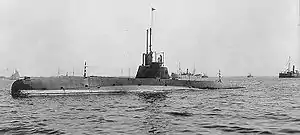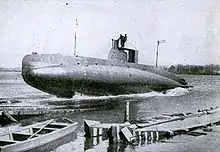USS C-3 (SS-14)
USS C-3 (SS-14) was one of five C-class submarines built for the United States Navy in the first decade of the 20th century.
 The USS C-3 underway, 1909. | |
| History | |
|---|---|
| Name: | USS Tarpon |
| Builder: | |
| Laid down: | 17 March 1908 |
| Launched: | 8 April 1909 |
| Sponsored by: | Katherine E. Theiss |
| Commissioned: | 23 November 1909 |
| Decommissioned: | 23 December 1919 |
| Renamed: | C-3, 17 November 1911 |
| Fate: | Sold for scrap, 12 April 1920 |
| General characteristics | |
| Class and type: | C-class submarine |
| Displacement: |
|
| Length: | 105 ft 4 in (32.11 m) |
| Beam: | 13 ft 11 in (4.24 m) |
| Draft: | 10 ft 11 in (3.33 m) |
| Installed power: |
|
| Propulsion: | |
| Speed: |
|
| Range: |
|
| Test depth: | 200 feet (61.0 m) |
| Complement: | 15 officers and enlisted |
| Armament: | 2 × 18 inch (450 mm) bow torpedo tubes (4 torpedoes) |
Description
The C-class submarines were enlarged versions of the preceding B class, the first American submarines with two propeller shafts. They had a length of 105 feet 3 inches (32.1 m) overall, a beam of 13 feet 10 inches (4.2 m) and a mean draft of 10 feet 10 inches (3.3 m). They displaced 240 long tons (240 t) on the surface and 273 long tons (277 t) submerged. The C-class boats had a crew of 1 officer and 14 enlisted men. They had a diving depth of 200 feet (61.0 m).[1]
For surface running, they were powered by two 240-brake-horsepower (179 kW) Craig gasoline engines, each driving one propeller shaft. When submerged each propeller was driven by a 115-horsepower (86 kW) electric motor. They could reach 11 knots (20 km/h; 13 mph) on the surface and 9 knots (17 km/h; 10 mph) underwater. On the surface, the boats had a range of 776 nautical miles (1,437 km; 893 mi) at 8.13 knots (15.06 km/h; 9.36 mph) and 24 nmi (44 km; 28 mi) at 8 knots (15 km/h; 9.2 mph) submerged.[1]
The boats were armed with two 18 inch (450 mm) torpedo tubes in the bow. They carried two reloads, for a total of four torpedoes.[2]
Construction and career

C-3 was laid down by Fore River Shipbuilding in Quincy, Massachusetts, under a subcontract from Electric Boat Company, as Tarpon. She was launched on 8 April 1909 as Tarpon sponsored by Katherine E. Theiss, and commissioned on 23 November 1909 with Lieutenant Prentiss P. Bassett in command.[3] She was renamed C-3 on 17 November 1911. The boat cruised along the east coast with the Atlantic Torpedo Fleet and the Atlantic Submarine Flotilla through the early 1913, operating in tests and exercises. From May to December 1913, she was based at Guantanamo Bay, Cuba, and on 12 December reported at Cristóbal, Panama Canal Zone. Her operations included exploration of anchorages, tactical drills, and harbor defense patrol at Canal Zone ports. In the summer of 1918, she patrolled off Florida, then returned to Panamanian waters. C-3 was placed in ordinary at Coco Solo, Canal Zone, on 22 August 1919, decommissioned there on 23 December 1919, and sold on 12 April 1920.
Notes
- Friedman, p. 306
- Gardiner & Gray, p. 127
- Pigboats (retrieved 27 February 2018)
References
- Friedman, Norman (1995). U.S. Submarines Through 1945: An Illustrated Design History. Annapolis, Maryland: Naval Institute Press. ISBN 1-55750-263-3.
- Gardiner, Robert & Gray, Randal, eds. (1985). Conway's All the World's Fighting Ships: 1906–1921. Annapolis, Maryland: Naval Institute Press. ISBN 0-85177-245-5.
- This article incorporates text from the public domain Dictionary of American Naval Fighting Ships. The entries can be found here and here.
External links
- Photo gallery of USS Tarpon at NavSource Naval History